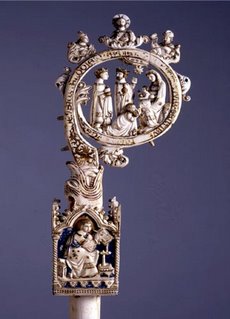He was learning about Our Lord, The Good Shepherd. His teacher asked what the staff was for. He knew that it was for protection. The Shepherd used his staff to protect the lambs from the wolves. Coming from the boy who got the coloring book, "Warriors Through the Ages" for Christmas- I was not too surprised.
It struck me that while I often think of the staff as a romantic pastoral element, a sturdy walking stick and reminiscent of the scepter by which the Bishop leads his diocese I don't usually think of the staff (or the crosier) in terms of protection.
And then there is the other subject of the staff in terms of discipline. But I think that was phased out in the 1960s. Just a guess.
And what are the bishops charged with protecting us against? The flock need to be protected against heresy, sin, dissent and laxity. You can even throw lack of charity in there, it's Sunday and I'm feeling generous.
Apparently even the abbess of a religious order and Our Lady of Good Success are entitled to carry the crosier.
This Crosier of St. Nicholas is made from carved ivory.

And two more examples of very beautiful and intricate crosiers.


The Bishop of London's Crosier, 1992. I think it would be best described as the "Crosier of the Shrieking Eels". Though I do understand this in terms of Numbers 21:8-9, it is still a bit startling.

And I didn't know that this explanation for the form of the crosier has been developed (organically I hope). From Wikipedia:
The traditional explanation for the form, beyond the obvious reference to the bishop as shepherd, is this: the pointed ferule at the base symbolizes the obligation of the prelate to goad the spiritually lazy; the crook at the top, his obligation to draw back those who stray from the faith; and the staff itself his obligation to stand as a firm support for the faithful.

5 comments:
Shameless plug coming:
Ask your son if he likes the nice men in red and the music at the top of my blog.
cheers
In the same Wikipedia article, in the next paragraph it says:
"The Eastern Orthodox and Eastern Rite Catholic crosier, in the Slavic tradition known as the "pateritsa", is found in two common forms. One is tau-shaped, with drooping arms, surmounted with a small cross. The other has a top comprising a pair of scupltured serpents or dragons curled back to face each other, with a small cross between them. The symbolism in the latter case is of the bronze serpents made by Moses in Numbers 21:8-9"
Granted it is odd for a Western 'bishop' to want an Eastern church crozier... but as a pastoral staff, it's firmly in the tradition.
Post a Comment